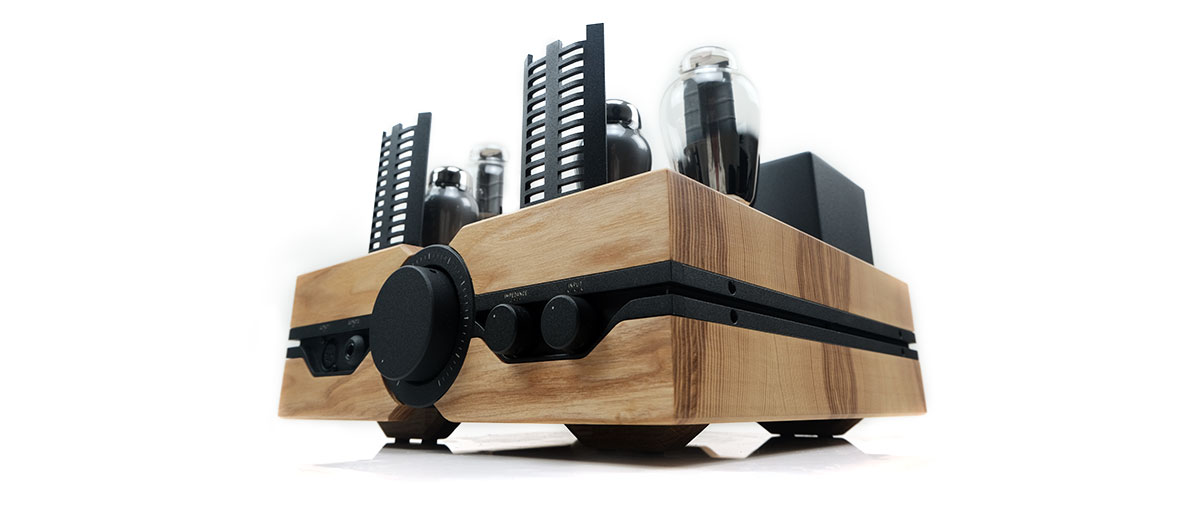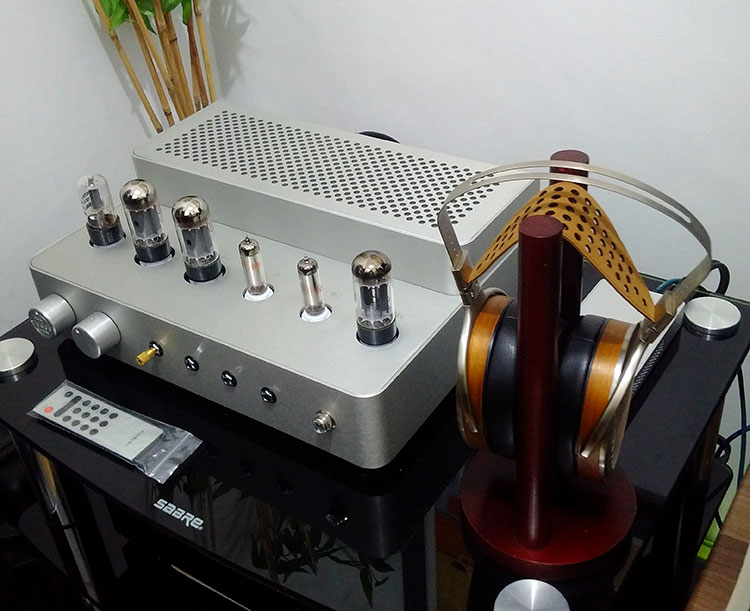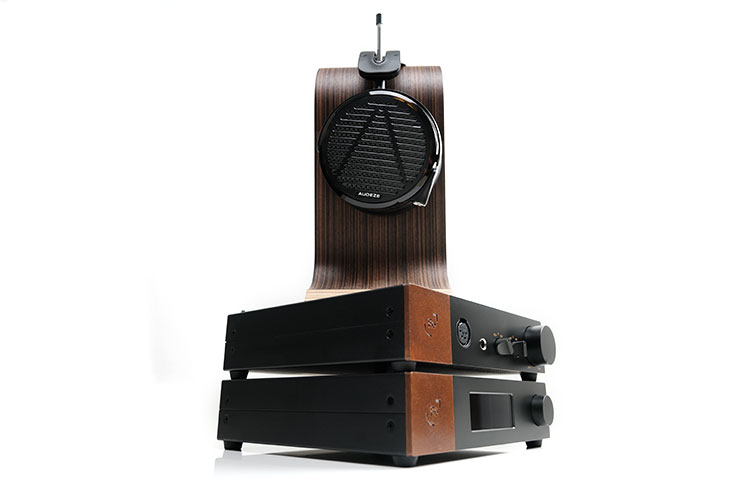Select Comparisons
For the comparisons, a Holo Audio Spring 2 DAC was hooked up to the amplifiers with some digital tracks of various resolutions fed in both SE and balanced.
Auris Audio HA-2SF
$2499
The Auris Audio HA-2SF is our award-winning tube amp from 2021 and though priced lower than the Envy its excellent performance merits a comparison in our opinion.
Technical
There is course some commonality with both using a single-ended pure Class A bias amplification design and a solid-state rectifier implementation. However, the mix of tubes and the output power ratings are quite different.
The Envy uses some pricey but very high-performing HA300B power tubes mixed with a pair of PsVane CV-181-T MKII drivers. The HA-2SF is a bit more modest with four JJ Electronics ECC99 9-pin double triode power tubes and a single input JJ Electronics ECC82 tube. The ECC82 is a 12AU7 medium gain pre-amplifying double triode design.
The output power is clearly in favor of the Envy with its top-tier 8W into 16Ω and most planars getting about 4-5W around 50-60Ω. The peak headphone output rating of the HA-2SF is lower at a maximum of 2W into 32Ω compared to 6W from the Envy on the same load.
For both amplifiers, impedance control up to 600Ω plays a central role and both cope wonderfully well in terms of current headroom at each level though I give the edge to Envy with its higher voltage levels. The functionality is not much different with the HA-2SF also offering a low, mid, and high setting with constant maximum output wattage through each unique range.
One small addition to the HA-2SF that is not found on the Envy is a high/low gain switch at the back of the amp. I am not entirely sure that is required with the Envy given the bump in both volume and dynamic range from the various impedance settings.
One larger difference is the external linear PSU with the HA-2SF, whereas the Envy houses its toroidal PSU internally. There may be advantages in terms of power filtering and noise control with the Auris approach.
Design
Both have superb designs, beautiful aesthetics, and a very neat and professional-looking finish to every aspect of their respective chassis.
The wood grain on both is gorgeous though for me the HA-2SF curving is a little more hand-friendly. The leather wrap and VU meters also give it a little more of a retro vibe though the big and bold lighting system of the HA-2SF might be more polarizing than the more discreet Envy which has none.
Of course, there are dimensional differences with the HA-2SF being marginally slimmer and its lighter weight split between the PSU at 3kg and the unit itself at 9kg. You might need a little more desktop space for the HA-2SF and its PSU compared to the Envy.
Dial placement is more user-friendly for me on the Envy. Aesthetically the HA-2SF looks more pleasing but the top panel placement makes it hard to see unless you are peering right down over it.
The Envy has its controls all on the front panel making it much easier to make quick adjustments. Luckily, the HA-2SF has a remote control but it only covers power and volume and not impedance selection. Still, it’s more than the Envy which has no remote control at all.
I/O is also very similar in terms of capability with 2 analog inputs and a single pre-amp output all controlled by a single selector dial to the front. However, whereas the Envy offers both balanced and SE options for both inputs and outputs, the HA-2SF only offers SE for the pre-amp output.
Performance
There are some variations in both the coloration and the technical performance. If you are using fairly demanding headphones it is probably the technical side that will leap out first given the Envy’s higher power and improved voltage headroom.
For example, with the Susvara the Envy delivers a vivid and immensely holographic soundstage with some excellent depth and height. The HA-2SF does very well but its lower output power shrinks the staging a bit in all directions so it can sound a little flatter and more compressed with the same headphones.
The channel separation and dynamic range of the Envy make a huge difference. The rise and fall of the note strikes are palpable with clear space between each one combined with excellent definition and texture within the note. Every instrument has its own distinct space, and moment to breathe, expressing itself clearly.
The HA-2SF has some additional warmth so the sound is denser to my ear but not quite as well separated for instruments. The low-end is perhaps less distinct and more neutral also for sub-bass weight and snap. You feel more drawn to the mids with its comparatively euphonic overtone and a softer more forgiving timbre compared to the exuberant articulation of the Envy.
The Envy’s stronger treble sparkle will deliver an airier mids, with a cleaner timbre and more percussion energy. Vocals do not have quite the same forwardness or focus as the HA-2SF but they have more space to breathe.
I would describe the Envy as delivering a much grander presentation so it’s less of an indistinct vocal performance and more of just hearing much more happening around them.
ALO Audio Studio 6
$3999
The ALO Audio Studio 6 has been one of our mainstays in the office for a number of years now despite us having never actually done a full review on it. Again, the price is a little lower but definitely worth a side-by-side with the Envy.
Technical
Like the HA-2SF, Studio 6 shares some common traits for technical specifications. Both amps have a Class-A single-ended amplifier with a “zero feedback” design.
However, Studio 6 uses a vacuum tube rectification with a “virtual dual monoblock” PSU as opposed to the solid-state version inside the Envy. So, to be precise, Studio 6 is a Class-A single-ended triode (SET) circuit design and will have more typical vacuum tube rectification ‘sag’ traits in its performance.
Unlike the Envy, Studio 6’s proprietary output stage has no impedance selection capability although it does cater for a 16Ω to 600Ω load parameter. Typically, however, I find Studio 6 to perform best for current with higher loads of 150Ω upwards.
The power capability of these two amps is where the Envy really pulls ahead with the Studio 6 offering a relatively modest 1W into 32Ω by today’s standards. Compared to the 8w into 16Ω down to 6W into 32Ω from the Envy and the lack of balanced I/O, the Studio 6 will struggle a bit for headroom with really demanding planars. The Envy is much more capable in this regard.
Design
A huge contrast in aesthetics and some divergence in terms of feature sets. Both are primarily headphone amplifiers but the Studio 6 lacks the pre-amp capability of the Envy. They do both have multiple analog inputs with 3 each, however, all 3 on the Studio 6 are SE dual RCA whereas one set is balanced on the Envy.
Switch to the front, and this is something I love about the Studio 6 with its 4 analog headphone outputs. Granted they are all SE but they all run at the same time meaning you can plug in 4 headphones same time and use a switch control to flick through them without diminution in power or dynamic range. That is a reviewer’s AB dream.
The Envy goes a different path with two PO outputs but one of them is balanced. The power rating from both is the same, however, so it is more for fitting purposes in the general scheme of things.
You can control the headroom on the Envy PO via the front panel impedance selector which is something Studio 6 does not offer. That is a welcome trait if you own high-load dynamic headphones as well as current demanding planars.
Looks-wise, take your pick from the aged steel retro 50s design of the Studio 6 or the warmer woody 40s noire of the Envy. Both have massive appeal and both units are fairly big and heavy. They demand top rack space and to be shown off. Neither comes with a remote control though.
Performance
Here you are going to hear the difference between a solid-state rectifier and a vacuum tube rectifier with a little more classic tube ‘sag’ in the Studio 6 low-end compared to the deeper, and more powerful bass signature of the Envy.
The Studio 6 bass is punchy, it’s not shallow at all, but its body and slam with headphones such as the LCD-5 is a shade softer compared to the tautness and weight of the Envy. In particular, you will notice considerably greater sub-bass reach and presence with the Envy when the audio calls upon it.
The dynamic range and headroom from the stronger Envy is also a factor and not just in the bass performance. The Studio 6 vocals seem further forward in the mix when paired with the LCD-5 but mainly due to the more relaxed and slightly softer imaging with instruments on either side of the vocals falling a little further back.
The Envy is much more vivid in its presentation meaning its staging draws you right in. Instrumental imaging is firmer, also more complex sounding, with the rise and drop in LCD-5’s attack and decay much more immediate and palatable.
Envy’s improved level of separation and slightly wider stereo imaging help a lot with the aforementioned. It is much easier to pick out the distinct individual instrumental passages from vocal performances whereas Studio 6 comparatively clips the wings a little on the extreme edges of the LCD-5 soundstage.
Ferrum OOR & HYPSOS
$3190
The Ferrum OOR/HYPSOS is also an award-winning solid-state amp bundle reviewed by us last year and an interesting alternative to the Envy given its excellent performance and similar power capability.
Technical
Hugely different internals with the OOR amplifier topology of a solid-state discreetly designed Class AB compared to the Envy’s Class A tube amplifier with a transformer-coupled balanced output and a solid-state rectifier.
Both amplifiers do feature pre-amping capability with the OOR offering a balanced preamplifier with volume and output control as well as bypass capability to act as a standalone headphone amplifier power stage. The Envy pre-amp out is volume-controlled with no fixed-line out capability and with nothing like the 3-stage gain control on the front panel of the OOR.
Instead, the Envy uses a 3-stage impedance control for varying loads up to 600Ω which some might find more beneficial than simply pushing up the gain levels.
In terms of raw power, the headline figure is the same at 8W PO output but it is not equally benchmarked. The 8W from the OOR is benchmarked at a higher 60Ω load rating but drops to 2W using its SE output. The 8W on the Envy is at 16Ω and you get closer to 6W at the 32Ω rating but this capability is for both balanced and single-ended outputs.
Power is the other major difference with the OOR coupled to the dedicated HYPSOS whereas the Envy houses its toroidal PSU inside its main chassis.
The HYPSOS is a hybrid switching and linear power supply but with a lot of control options including variable voltage control and preconfigured settings for a wide range of amplifiers. Perhaps even the Envy will be one of them in time.
Design
Even with the HYPSOS underneath the OOR bundle is very compact and discreet compared to the grandiose of the wood-themed Envy tube amplifier. Being smaller and infinitely lighter, the OOR/HYPSOS won’t really need a rack, it is compact enough to sit right on a reasonably small table as part of a digital setup.
They are worlds apart in aesthetics with the OOR’s low-profile black and terracotta color banding and the Envy’s high-impact oak wood grain and tall wide-shouldered H300B tubes dominating any rack. No doubt the Envy’s overt styling will catch most people’s eye first.
The feature set, however, is just as good for both with the only major difference between how many of each option you have and the gain versus impedance selection front panel controls.
Both the OOR and the Envy have a single pre-amp output in both XLR and dual RCA in the rear. However, the Envy has more capacity in terms of connecting analog inputs from digital sources compared to the OOR with double the input options in both balanced and SE.
Performance
These are two very competitive amplifiers, at least in terms of dynamic range and headroom for the likes of the Susvara and the Diana Phi, our two tested headphones for this comparison. Neither sounded compressed, both had very black backgrounds with the only real differences coming in terms of the synergy with your headphone of choice.
Now, in terms of sheer power, the OOR might have a small edge considering its peak 8w output is at 60Ω, and indeed if I have to cast a deciding vote on which is the more robust I might say the OOR over the Envy.
However, it isn’t always the case that this is the overriding perception. At times it is the Envy that sounds the more grandiose and I suspect the coloration might be a factor here.
For me, the OOR is transparent, letting that natural tone of the Holo Spring 2 DAC shine through beautifully but adding nothing more to it really. This is a reference turning, very neutral, and very much down the line with perhaps a little lower-mid density and vocal emphasis which you could argue is more of an attribute of the DAC.
The Envy adds more coloration but is still quite pure in tone. There is some treble sparkle, a little more elasticity in the bass response, and a midrange that is a bit more delicate sounding. The appropriate phrase here is that a slice of sweetness seems to have been thrown into the coloration but still with excellent PRaT.
As a result, your ear’s focus is split a bit between the contrasting bass depth and pure treble overtones of the more grandiose Envy staging whereas the OOR keeps its more on the physical and linear side with those lower mids to vocal taking a bit more focus.
Our Verdict
The Feliks Audio Envy is an absolute cracker of a tube amp. Yes, it is beyond affordable for many but for owners of the likes of the Susvara, Diana Phi, DCA Stealth, and any demanding headphone it is an almost mandatory demo just to see how well these headphones sing with this creation.
You may well be tempted and why not? The Envy’s sweet overtone, massive staging quality, and hugely impressive dynamic low-end made for some very enjoyable listening.
My only critique is to make sure you get a quality DAC behind it to maximize its potential. It does not have to be an ultra-expensive source like dCS’s Ring DAC, for example. The more affordable R2R-based Holo Audio Spring 2 had a perfect tonal synergy for my tastes, especially using the balanced outs.
The Envy also looks the business with those oak and American walnut options. You will have your preferences, I have mine but do make sure you have that free space on the top of the HiFi rack. You are going to want to show this one off, a lot!
Feliks Audio Envy Specifications
- Power tubes: 300B
- Driver tubes: PsVane CV-181 mk2 (6SN7)
- 2x unbalanced RCA inputs (IN1, IN2)
- 1x balanced XLR input (IN3)
- Input sensitivity 1V RMS
- Input impedance: For IN1 i IN2 (RCA) 100kΩ, For IN3 (XLR) 10kΩ
- 1x pair of pre-amplifier output as RCA
- 1x pair of pre-amplifier output as XLR
- Maximum voltage on the above outputs is 5V (RMS) at an output impedance of 600Ω and THD<0,5%
- Impedance selector guidance: LO – up to 60Ω, MID – up to 300Ω, HI – up to 600Ω–mnh
- Amplifier’s impedance: LO at 32Ω load is 3,8Ω, MID at 100Ω load is 8,8Ω, HI at 600Ω is 20Ω
- Output power measured at MID impedance setting at a load of 16Ω is 5W with THD ⩽1% (maximum 8W at THD >5%)
- Frequency response: 8Hz÷100kHz ±3dB, 18Hz÷40kHz ±1dB
- Headphone outputs: 6.3mm and XLR
- AC voltage 50/60Hz: 230V version (±5%), 115V version (±5%)
- Power consumption: 110VA
- Weight: 15,1kg (without packaging)
- Dimensions: 35x33x18,5cm (LxWxH) – without tubes, 35x33x24,5cm (LxWxH) – with tubes









